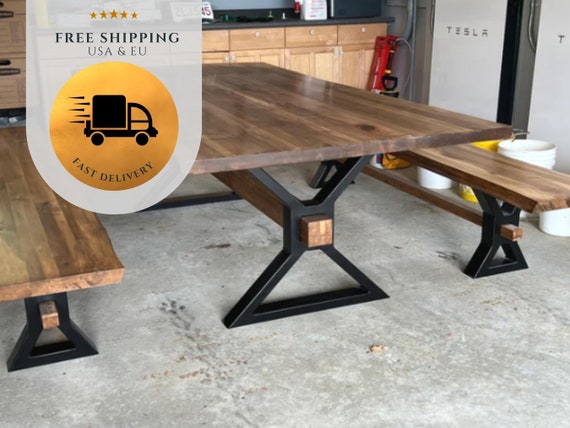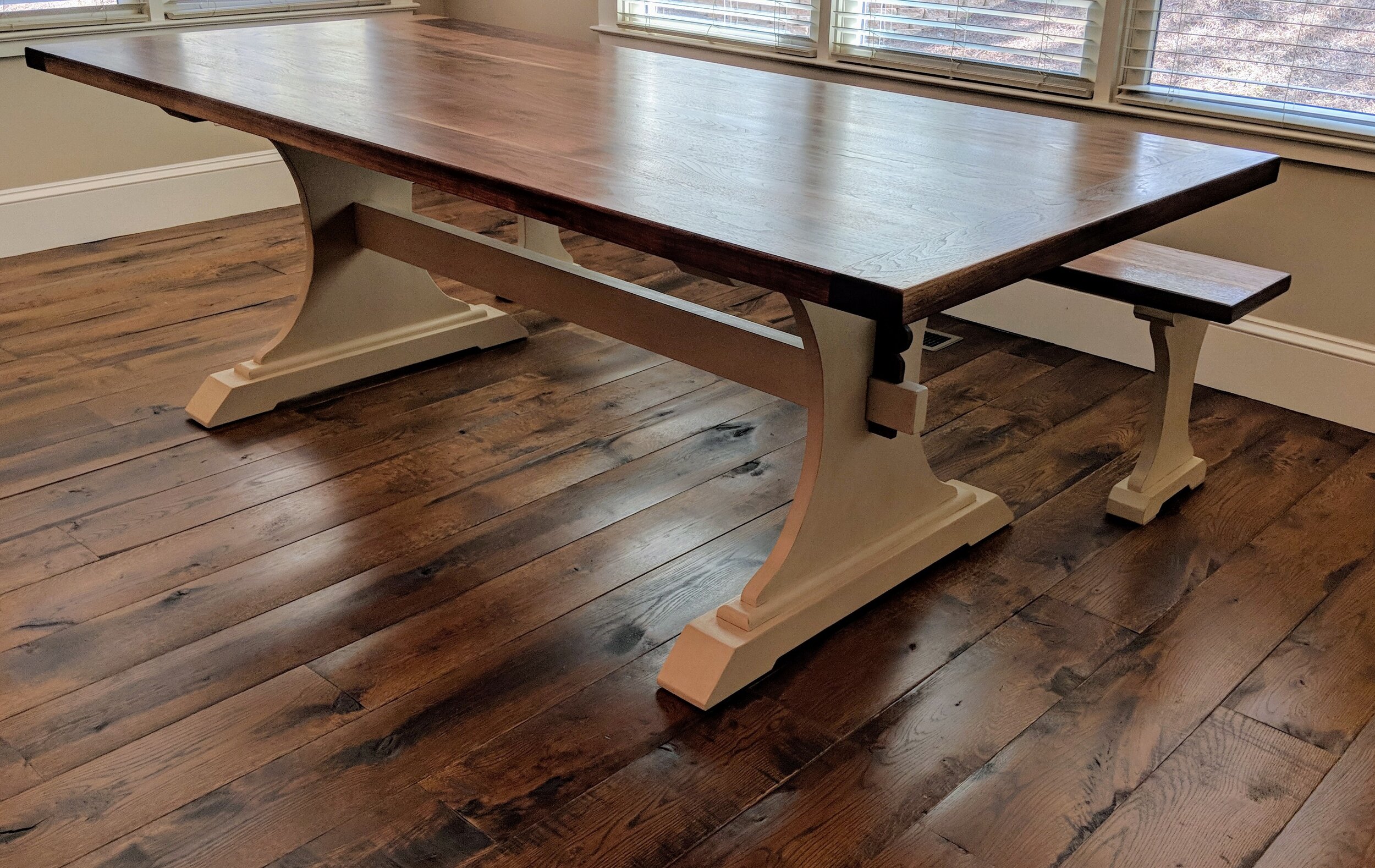From Standard to Modern: Discover the Perfect Dining-room Table Legs for Your Design
The option of dining-room table legs plays a critical duty in specifying the general character of your space, linking the gap between conventional workmanship and contemporary looks. While timeless designs such as cabriole and turned legs evoke a feeling of timeless class, modern styles like barrette and geometric options provide a possibility for striking visual rate of interest. Reviewing the right balance in between these designs requires a nuanced understanding of your existing design and individual preference. As you think about these aspects, the concern stays: how can you seamlessly integrate these diverse leg designs to produce an unified eating experience?
Understanding Table Leg Styles
The range of eating space table leg styles can considerably affect both the visual appeals and capability of the room. Each leg style adds distinct aesthetic aspects and functional features, catering to varied layout choices and usage needs. Recognizing these styles is important for choosing the best dining table that lines up with your general indoor style vision.
For example, conical legs provide a clean, classic look that can improve an area's elegance, while stand bases supply stability and optimize legroom, making them perfect for smaller sized spaces. Barrette legs, a trademark of mid-century modern design, introduce a commercial style, permitting an airy, open feel. In a similar way, trestle legs stimulate rustic appeal, supplying durable support and a sense of timelessness.
Moreover, the choice of products plays a substantial duty. Wooden legs can bring warmth and structure, whereas steel alternatives frequently convey a sleek, contemporary ambiance. Ultimately, understanding table leg styles is necessary for creating a natural dining location that mirrors individual design while making certain functionality and comfort. By attentively taking into consideration these elements, you can improve both the useful and visual charm of your dining room.
Standard Table Leg Options
When choosing dining-room table legs, traditional alternatives frequently symbolize classic sophistication and craftsmanship. These layouts reflect an abundant heritage and a dedication to top quality, making them perfect for those that appreciate traditional looks.
Among the most famous typical leg designs is the cabriole leg, defined by its graceful curved shape. This layout usually features ornamental carvings and is most frequently found in Queen Anne and Chippendale furnishings. Another popular choice is the transformed leg, which boasts a collection of smooth, rounded shapes that give a traditional appearance while maintaining security.
Moreover, the straight leg, while basic, supplies a basic and strong framework that can mix perfectly with a variety of tabletop designs. For those attracted to ornate detailing, claw-and-ball feet legs stimulate a feeling of majesty and can serve as a spectacular prime focus in any eating space.
Finally, pedestal bases, although not purely legs, give an alternate standard option that allows for enough legroom and can be beautifully carved. Each of these standard leg designs adds to the general setting of a dining space, marrying function with aesthetic charm.

Modern Table Leg Layouts
Modern table leg designs supply a varied series of designs that emphasize ingenious products and clean lines. These layouts typically focus on performance while functioning as striking prime focus within a dining space. Minimalist visual appeals are prevalent, with legs crafted from materials such as metal, glass, and engineered timber, which add to a airy and modern feeling.
One popular layout is the hairpin leg, defined by its slim, tapered structure that offers stability without frustrating the table top (dining room table legs). This style is often discovered in mid-century contemporary furnishings and can easily complement various table forms. An additional fad is the use of geometric forms, where legs might tackle unbalanced or angular types, adding aesthetic passion and a touch of creativity

Mixing Styles for Unique Spaces
Frequently, home owners seek to produce distinct dining areas that mirror their individual design by blending various layout components. This method permits for the unification of diverse visual appeals, leading to an unified yet unique environment. Matching a rustic wood table with smooth, modern-day steel legs can develop an attractive comparison that raises the area's overall appeal.
In addition, integrating vintage table legs with contemporary table tops can stimulate a sense of background while preserving a contemporary sensibility. Such combinations not only showcase private taste yet likewise urge creative thinking, permitting property owners to curate a room that really feels both personal and inviting.
Color plays an important duty in this blending procedure; choosing table legs that match or comparison with the existing color system can boost visual rate of interest. Whitewashed legs can soften the boldness of a dark table surface, developing a balanced aesthetic.
Tips for Picking the Right Legs
Selecting the right table legs is essential for accomplishing both performance and visual allure in your eating room. Begin by taking into consideration the general style of your space. Traditional settings take advantage of legs that include intricate carvings or transformed designs, while modern areas internet may require streamlined, minimal styles.
Next, examine the height and stability of the legs. dining room table legs. Common eating tables range between 28 to 30 inches in height, so make sure the legs match this measurement for comfort. In addition, robust products, such as hardwood or steel, can enhance stability and long life
Evaluate the leg shape also-- choices consist why not try these out of straight, tapered, or pedestal styles. Straight legs supply a timeless appearance, while tapered legs can include a touch of sophistication. Pedestal bases offer adequate legroom and are perfect for smaller rooms.
Conclusion
In summary, selecting the suitable eating space table legs requires cautious consideration of both modern-day and traditional designs. Typical options such as cabriole and transformed legs offer ageless sophistication, while modern styles like barrette and geometric shapes offer a modern touch. By integrating leg style, height, and product with the general decor, a cohesive and welcoming atmosphere can be achieved. Inevitably, the selected table legs should mirror the preferred aesthetic, enhancing the eating experience within the area.
The range of eating space table leg styles can substantially influence both the aesthetic appeals and capability of he has a good point the area. Ultimately, comprehending table leg designs is crucial for producing a cohesive dining area that shows individual style while making sure functionality and convenience.One of the most renowned traditional leg styles is the cabriole leg, characterized by its graceful curved shape. Straight legs offer a timeless appearance, while tapered legs can add a touch of elegance.In summary, choosing the perfect eating space table legs needs mindful consideration of both traditional and modern-day designs.